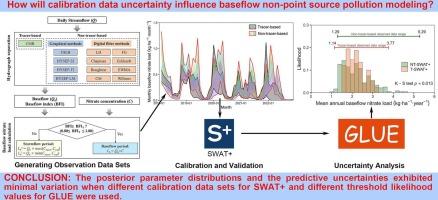校准数据的不确定性如何影响基流中非点源污染物负荷的建模
IF 3.5
3区 环境科学与生态学
Q2 ENVIRONMENTAL SCIENCES
引用次数: 0
摘要
基流是非点源 (NPS) 污染物的主要迁移途径。根据低质量数据校准的流域水质 (WWQ) 模型可能会对基流非点源污染物负荷产生误导性预测,从而导致管理决策失误。我们评估了伊利湖西南部休伦河流域的基流硝酸盐负荷模型如何受到校准数据不确定性的影响。根据日溪流、硝酸盐浓度和比导的五年时间序列,使用各种基于示踪剂和非基于示踪剂的水文图分离方法,结合有关基流硝酸盐浓度的假设,估算了两组包含不确定性的 "观测 "基流硝酸盐负荷数据。我们用两组 "观测 "数据校准了水土评估工具+(SWAT+)模型,并使用广义似然不确定性估计(GLUE)方法量化了参数和预测的不确定性。结果表明,基流占休伦河流域年均总流量(11.8 立方米/秒)的 26%-34%,占年均总硝酸盐负荷(14.3 千克-公顷-1-年-1)的 8%-37%。非示踪剂方法得出的基流和硝酸盐负荷估算值与示踪剂方法得出的估算值相似,但不确定性更大。当 SWAT+ 使用不同的校准数据集和 GLUE 使用不同的阈值似然值时,后验参数分布以及模拟基流硝酸盐负荷的加权平均值和 90% 预测区间的变化极小。我们的分析强调,在解决与基流有关的水质问题时,必须用基流污染物负荷/浓度校准水质模型。它还证明了利用多种非示踪剂水文图分离方法估算基流 NPS 污染物负荷的可行性。与基于示踪剂的方法相比,这些非示踪剂方法简单易用,适用范围更广。这项研究深入探讨了校准数据的不确定性如何影响基流中的核动力源污染建模,并强调了非示踪剂水文图分离法的实用价值。本文章由计算机程序翻译,如有差异,请以英文原文为准。

How uncertainty in calibration data affects the modeling of non-point source pollutant loads in baseflow
Baseflow is a major transport pathway for non-point source (NPS) pollutants. Watershed water quality (WWQ) models calibrated by low-quality data may produce misleading predictions of baseflow NPS pollutant loads, resulting in poor management decisions. We evaluated how models of the baseflow nitrate loads in the Huron River basin, southwest of Lake Erie, were affected by uncertainty in the calibration data. Based on a five-year time series of daily streamflow, nitrate concentration, and specific conductance, two sets of “observed” baseflow nitrate load data that include uncertainty were estimated using various tracer-based and non-tracer-based hydrograph separation methods, in conjunction with assumptions regarding baseflow nitrate concentrations. We calibrated the Soil and Water Assessment Tool plus (SWAT+) model with the two “observed” data sets and used the Generalized Likelihood Uncertainty Estimation (GLUE) approach to quantify parameter and predictive uncertainties. The results showed that baseflow accounted for 26 %–34 % of the mean annual total streamflow (11.8 m3/s) and 8 %–37 % of the mean annual total nitrate load (14.3 kg·ha−1·year−1) in the Huron River basin. The baseflow and nitrate load estimates from the non-tracer-based methods resembled those from the tracer-based method but had greater uncertainty. The posterior parameter distributions, as well as the weighted means and 90 % prediction intervals of the simulated baseflow nitrate loads, exhibited minimal variation when different calibration data sets for SWAT+ and different threshold likelihood values for GLUE were used. Our analysis emphasizes the necessity of calibrating WWQ models with baseflow pollutant loads/concentrations when addressing water quality issues related to baseflow. It also demonstrates the feasibility of utilizing multiple non-tracer-based hydrograph separation methods to estimate baseflow NPS pollutant loads. These non-tracer-based methods offer a simplicity and broader applicability compared to tracer-based methods. This study has provided insights into how calibration data uncertainty impacts the modeling of NPS pollution in baseflow and highlights the practical value of non-tracer-based hydrograph separation methods.
求助全文
通过发布文献求助,成功后即可免费获取论文全文。
去求助
来源期刊

Journal of contaminant hydrology
环境科学-地球科学综合
CiteScore
6.80
自引率
2.80%
发文量
129
审稿时长
68 days
期刊介绍:
The Journal of Contaminant Hydrology is an international journal publishing scientific articles pertaining to the contamination of subsurface water resources. Emphasis is placed on investigations of the physical, chemical, and biological processes influencing the behavior and fate of organic and inorganic contaminants in the unsaturated (vadose) and saturated (groundwater) zones, as well as at groundwater-surface water interfaces. The ecological impacts of contaminants transported both from and to aquifers are of interest. Articles on contamination of surface water only, without a link to groundwater, are out of the scope. Broad latitude is allowed in identifying contaminants of interest, and include legacy and emerging pollutants, nutrients, nanoparticles, pathogenic microorganisms (e.g., bacteria, viruses, protozoa), microplastics, and various constituents associated with energy production (e.g., methane, carbon dioxide, hydrogen sulfide).
The journal''s scope embraces a wide range of topics including: experimental investigations of contaminant sorption, diffusion, transformation, volatilization and transport in the surface and subsurface; characterization of soil and aquifer properties only as they influence contaminant behavior; development and testing of mathematical models of contaminant behaviour; innovative techniques for restoration of contaminated sites; development of new tools or techniques for monitoring the extent of soil and groundwater contamination; transformation of contaminants in the hyporheic zone; effects of contaminants traversing the hyporheic zone on surface water and groundwater ecosystems; subsurface carbon sequestration and/or turnover; and migration of fluids associated with energy production into groundwater.
 求助内容:
求助内容: 应助结果提醒方式:
应助结果提醒方式:


